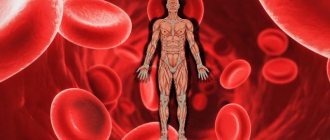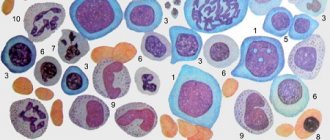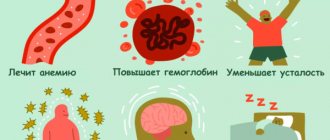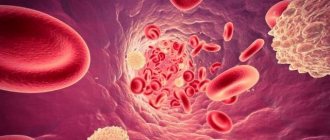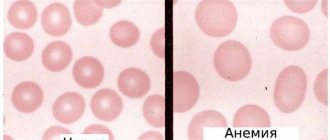Published: 05/18/2018 Updated: 03/09/2021
Anemia is a dangerous condition. In children, it provokes a slowdown in mental and physical development, and speech impairment. In pregnant women, it can cause fetal pathologies and complications for the mother. Vegetarians and those who constantly adhere to low-protein diets are at risk of decreased performance, cognitive function, headaches and dizziness. If you feel that you are sorely lacking in energy and strength, get tested. More than half of all anemias remain undiagnosed. And without laboratory tests it is impossible to detect anemia.
What is anemia?
Anemia is a condition associated with a decrease in hemoglobin levels in the blood (below 110 g/l). Often accompanied by a decrease in the number of red blood cells - red blood cells or their total volume.
The main function of red blood cells is to transport oxygen from the lungs to various organs and tissues and remove carbon dioxide. The transport function is carried out thanks to hemoglobin, the main component of red blood cells. Hemoglobin consists of the protein (globin) iheme, which in turn consists of ferrous iron and protoporphyrin IX. 70% of the iron in the body is found in red blood cells.
What are the main symptoms of anemia in women?
The main symptoms of anemia in women develop when the disease reaches moderate severity. In this case, hemoglobin drops to 70-90 g/l.
The main manifestations of moderate anemia include:
- Circular hypoxic syndrome.
As anemia progresses, the skin and mucous membranes become very pale and undergo trophic changes. Women increasingly begin to experience dizziness, which can lead to fainting. The heartbeat quickens; if you already have any diseases of the cardiovascular system (coronary artery disease, heart failure), then anemia will aggravate their course. During exercise, and then at rest, the woman will begin to experience shortness of breath.
- Sideropenic
syndrome.
The skin becomes covered with cracks, ulcers form in the mouth, which take a long and painful time to heal. The tongue often becomes inflamed. Women begin to complain of abdominal pain, and when examining the organs of the digestive system, they are often diagnosed with atrophic gastritis. From time to time there may be a desire to smell some specific smells (acetone, paint, gasoline), or eat some unusual food (chalk, tooth powder, clay). Sideropenia is indicated by muscle weakness, uncontrolled urination, and dyspepsia. - Asthenovegetative syndrome.
Irritability intensifies, the woman becomes whiny and hot-tempered. Memory and attention continue to deteriorate.
- Immune system disorders.
As anemia progresses, the body's natural defenses are weakened. Therefore, a woman often begins to suffer from ARVI and intestinal infections.
Causes of anemia
There are quite a few factors that provoke anemia. Anemia can occur due to:
- unbalanced diet (iron deficiency, deficiency or excess of vitamin B12, vegetarianism);
- disorders of folic acid metabolism;
- increased need of the body for nutrients (growth period - adolescence, pregnancy);
- frequent infectious diseases (cytomegalovirus, herpes virus, hepatitis);
- heavy metal poisoning.
In addition, anemia often accompanies diseases of the gastrointestinal tract (chronic gastritis), develops against the background of helminthic infestations, especially often in children (parasites attach to the intestinal wall and can cause bleeding), uterine bleeding (heavy menstruation, endometriosis).
What is the danger of long-term anemia?
Even mild anemia, if persisted for a long time, can cause serious damage to health! Prolonged oxygen starvation of tissues (hypoxia) leads to metabolic disorders, accumulation of toxic metabolic products, and excessive load on life-support organs - the heart, lungs, as well as excretory organs - liver, kidneys.
As a result of chronic hypoxia, sclerotic processes develop in tissues and organs - normal, working tissue is replaced by sclerotic (conditionally “scar”), as a result of which organs begin to gradually lose their function - cardiosclerosis develops with manifestations of heart failure (shortness of breath, edema, decreased exercise tolerance ), heart rhythm disturbances, respiratory failure, the function of the liver, kidneys, blood vessels, endocrine organs, and brain suffers. A person, without noticing it, acquires chronic diseases, loses his ability to work, becomes emotionally labile, depressed, and his immunity decreases. In addition, against the background of chronic anemia, any acute disease, be it a viral infection, tonsillitis, or more serious illnesses, is much more severe, dangerous complications develop much more often due to the fact that there are simply no compensatory capabilities in the body, they are depleted by a long-term hypoxic state.
In order to avoid the development of chronic diseases against the background of anemia, long-term, debilitating, and sometimes expensive treatments, you must follow simple rules:
- undergo an annual preventive examination - for a healthy person it will be enough to take a general blood and urine test, undergo fluorography and visit a therapist, gynecologist (urologist) and dentist.
- When identifying symptoms of chronic diseases that can lead to the development of anemia, promptly correct them.
- If there are signs of chronic bleeding, promptly diagnose and treat the diseases that cause them.
This is especially true for women with gynecological problems . Often, women are accustomed to enduring all hardships and long, heavy menstruation is considered almost a variant of the norm! This is fundamentally wrong - on the one hand, very often after treatment it is possible to restore the normal menstrual cycle quite easily and there is simply no reason for anemia; on the other hand, long, heavy periods, especially in women after 40 years of age, can be the first symptoms of oncological diseases of the female sphere !
- anemia must be treated! Even if you have mild anemia, it is necessary to promptly correct your hemoglobin level - sometimes just a diet and a monthly course of taking iron supplements are enough to restore normal blood counts and prevent the development of adverse long-term consequences!
At the ACMD-MEDOX clinic, almost all the necessary research methods for diagnosing anemia are available. Comfortable conditions, professional specialists, and modern equipment will allow you to undergo the necessary examinations painlessly and in the shortest possible time.
Experienced doctors at our center will help you identify the first signs of anemia in the early stages, understand the causes of its occurrence and prescribe adequate therapy for the identified pathologies! Be healthy!
How to recognize anemia?
Typical symptoms of anemia caused by hypoxia of organs and tissues are dizziness, fatigue, weakness, tinnitus, shortness of breath when climbing stairs, decreased performance. There is also a decrease in appetite, pale skin (in some cases yellowing), and “stubs” in the corners of the mouth. Hair may begin to fall out and the condition of nails may deteriorate. In addition, the mood changes and apathy and irritability appear, even if everything is fine.
If you notice such changes, do not rush to take iron or vitamin supplements or take B12 injections. The doctor gives a conclusion about anemia based on laboratory parameters. And taking medications on your own can be unsafe.
The first signs of anemia in women after 30
Female anemia has certain characteristics of its course. It begins to develop when the hemoglobin level drops to 90-120 g/l. This anemia is considered mild and may not manifest itself in any way. However, if a woman is attentive to her health, then she will still notice minimal signs of a developing disorder.
The first symptoms of anemia in women after 30 include:
- Decreased performance. All those tasks and responsibilities that a woman previously performed will now be difficult for her.
- During the day, sleepiness begins to bother her more and more often, despite the fact that the woman has not changed her daily routine and has enough time to sleep at night.
- Floaters and flashes periodically appear before the eyes.
- When in a cool room, a woman will feel very cold. Such an unexpected reaction to low temperature should lead to the idea of developing anemia.
- The skin of the face becomes dry, wrinkles and cracks appear on it.
- The mucous membranes suffer from ulcerations.
- You definitely need to pay attention to nails that become brittle and dull, and longitudinal stripes may appear on them.
- Anemia affects the condition of the hair. At the age of 30, a woman may find that her hair begins to turn gray and fall out.
- From the mental perspective, changes caused by anemia are more difficult to notice, but most women still note that they have become much more irritable and whiny. There is a weakening of memory and concentration.
The listed symptoms may not develop fully and not always. However, anemia cannot manifest itself completely asymptomatically. The main thing is to listen to your body and not ignore its signals.
Diagnosis of anemia
To diagnose anemia at CITILAB you can undergo the following tests:
- 11-10-001 – General blood test
- 95-13-211 – Vitamin B12
- 33-20-038 – Folic acid (folates)
- 26-20-100 – Serum iron
You can also run profile 99-00-026 - “Chronic Anemia”, which includes additional parameters for diagnosing and determining the type of anemia. For example, ferritin, which reflects how much ferric ions are deposited; total serum binding capacity, haptoglobin, transferritin and other important indicators.
Its manifestations:
- Pale, slight yellowness of the hands and nasolabial triangle;
- Shortness of breath, increased heart rate, fainting (especially with a rapid transition from a horizontal to a vertical position);
- Palpitations, chest pain;
- Increased fatigue;
- Weakness, dizziness, flashing “spots” before the eyes, drowsiness during the day and insomnia at night, impaired concentration, decreased memory, performance, irritability, tearfulness;
- Loss of appetite, nausea, flatulence;
- Swelling of the face in the morning.
Patients often get used to their condition, regarding it as overwork, stress, etc.
Replenish iron deficiency
To prevent iron deficiency anemia, in addition to the iron or vitamin supplements prescribed by your doctor, it is recommended to change your diet after receiving test results. It must contain foods rich in iron and microelements (copper, cobalt, manganese, nickel, vitamin C), which help the absorption of this vital essential metal.
| Foods high in Fe (>5 mg/100 g product) | Foods with moderate Fe content (1-5 mg/per 100 g of product) | Foods rich in copper, nickel, cobalt, manganese, vitamin C |
|
|
|
Interesting fact. Iron is best absorbed from meat products.
Treatment of IDA
The goal of treatment for IDA is to replenish iron stores in the amount necessary to normalize hemoglobin levels (in women 120–140 g/l) and replenish tissue iron stores (SF>40–60 μg/l). For treatment and prevention, oral preparations of iron salts are used, most often ferrous sulfate; in recent years, iron fumarate, iron gluconate, or combination preparations have also been actively used. The quantitative and qualitative composition of iron medicinal preparations varies greatly; depending on this, the preparations are divided into high- and low-dose, single-component and combined. In accordance with the WHO recommendation, the optimal dose of iron for the treatment of IDA is 120 mg/day, for the prevention of iron deficiency - 60 mg/day [7]. Approximately 20% of patients develop diarrhea or constipation during treatment, which can be relieved with symptomatic therapy. Signs of stomach irritation, such as nausea and epigastric discomfort, are minimized by taking iron supplements with meals or reducing their dose. The use of high-dose iron supplements is accompanied by an increase in the frequency of side effects from the gastrointestinal tract. The duration of treatment is determined by the depth of the initial iron deficiency and can vary from 1 month. up to 3 months [6–9, 19].
There is now accumulating evidence that low-dose iron supplements, given in short courses (2 weeks per month) or in an alternative regimen (every other day for a month), have higher effectiveness and lower incidence of side effects than previously used high-dose preparations. including in the form of repeated (2–3 times a day) doses [7, 33, 34].
It is important to emphasize that high doses of iron supplements may be associated with oxidative cytotoxic effects of unabsorbed iron on the intestinal mucosa, which is clinically manifested by side effects such as nausea, vomiting, constipation or diarrhea. Other adverse effects of unabsorbed iron include disturbances in the composition of the gut microbiome, with a decrease in lactobacilli and bifidobacteria and an increase in potential pathogens ( Enterobacteriaceae
), which entails the development of inflammation and diarrhea [31]. Modification of the iron supplementation regimen, such as switching from daily to alternative and from 2–3 times to once a day, may increase the effectiveness of treatment and improve its tolerability [33–35].
An example of a modern iron drug is the combination drug Ferretab® comp. One capsule of the drug includes 3 mini-tablets containing iron fumarate 163.56 mg (equivalent to 50 mg of iron), 1 mini-tablet of folic acid 0.54 mg (equivalent to 0.5 mg of dry matter) and auxiliary components. The folic acid mini-tablet dissolves within minutes and is rapidly absorbed in the jejunum. Iron is built into the inert matrix of the mini-tablet, which avoids high concentrations upon release and prevents irritation of the mucous membrane. Iron absorption occurs directly in the duodenum and upper jejunum. During the passage of the mini-tablet through the intestines, continuous release and absorption of iron occurs, providing a prolonged effect of the drug with a single daily dose.
The advantage of the drug is its combined composition: active divalent iron (iron fumarate) and folic acid, which is a hematopoietic cofactor vitamin necessary for the growth and differentiation of bone marrow erythroid cells. This increases the effectiveness of treatment, as demonstrated in a meta-analysis in 2015 [36]. During pregnancy, folic acid protects the fetus from the effects of teratogenic factors [37].
The drug does not have a specific taste or smell of iron, does not stain tooth enamel, is well tolerated and convenient for use: 1 tablet per day.
Treatment with parenteral iron is recommended for IDA in cases of ineffectiveness, poor tolerability, or contraindications to the use of oral iron medications [4, 6, 7, 9]. The use of intravenous iron supplements is indicated primarily for absorption disorders due to previous extensive intestinal resection, for inflammatory bowel diseases (ulcerative colitis, Crohn's disease) and malabsorption syndrome, for chronic kidney disease in the predialysis and dialysis periods, and also if necessary to obtain a quick effect in in the form of replenishing iron reserves and increasing the efficiency of erythropoiesis (for example, before major surgical interventions) [6, 7, 9, 27].
Intravenous infusions of iron preparations are associated with the danger of anaphylactic shock (in 1% of cases), the development of iron overload and toxic reactions associated with the activation of free radical reactions of biological oxidation (lipid peroxidation) by iron ions.
Intramuscular administration of iron preparations has not been used for a long time due to low efficiency, the development of local hemosiderosis and the risk of developing infiltrates, abscesses and even myosarcoma at the injection site.
Physiological norms of iron and vitamin B12 and folic acid
In different countries, the average iron intake varies from 10 to 22 mg/day. According to the standards recommended in Russia, for men this level is 8-10 mg/day, for women it is 1.5 times more - 15-20 mg/day. For children - 4-18 mg/day. A sufficient level of folic acid for adults is 400 mcg/day, for children - from 50 mcg every day. Men and women should get at least 3 mcg/day of vitamin B12.
Be healthy!
Author:
Baktyshev Alexey Ilyich, General Practitioner (family doctor), Ultrasound Doctor, Chief Physician
Complications of pregnancy with iron deficiency anemia
Anemia in pregnant women is a pathological background that contributes to the development of a number of complications of pregnancy and childbirth.
- Premature abruption of a normally located placenta, anomalies of labor.
- Increased blood loss during childbirth and bleeding - in 10% of women.
- In 8–12% of cases, the postpartum period is complicated by purulent-septic diseases and uterine subinvolution.
- A lactation disorder was detected, and both quantitative and qualitative changes in breast milk were observed.
- Adverse effects on the condition of the fetus: contributes to the development of fetal growth retardation syndrome, chronic fetal hypoxia.
- A decrease in adaptation of newborns in the early neonatal period is recorded in half of the cases.
